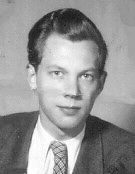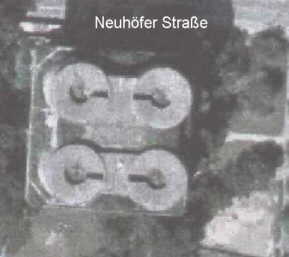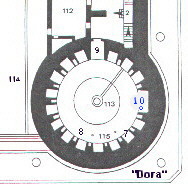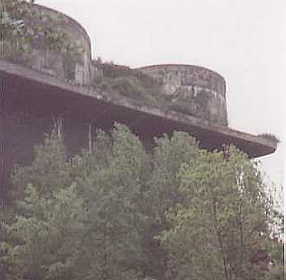As Luftwaffenhelfer (schw.zbv. 2./414)
upon the Flaktower VI in Hamburg-Wilhelmsburg
by Gustave H. Roosen (updated 05. 01. / 2002)
 Preface: As already mentioned in the Aachen report I like to state, that the following war-related events, as experienced by
a 16 year old Flakhelfer, are not intended to glorify any aspect of
Hitler's Third Reich.
Preface: As already mentioned in the Aachen report I like to state, that the following war-related events, as experienced by
a 16 year old Flakhelfer, are not intended to glorify any aspect of
Hitler's Third Reich.I am obliged again to Mr. John Milloy, Kingston / Canada for translation even this original report from German into English. The Author
Hamburg-Wilhelmsburg, an anti-aircraft gun tower with four 128mm twin guns, one per corner of the tower, was for us, the former Monschau High School students, the third and the last posting, after the action in Aachen. In Aachen the U.S.Artillery had pulled the plug on us and after a guest appearance in Langenbochum in the Ruhr beside the colliery "Schlegel & Eisen", we finally arrived here in Hamburg. On to the last battle! We arrived in Hamburg on November 14th, 1944. As a young boy I had grown up in this city and I knew my way around. What a sight Hamburg was now! The Binnenalster was covered with camouflage nets; the main railway station had a covering of straw mats of road width over it; and over the Außenalster a dummy fabrication of the Lombardsbrücke, the Lombard bridge, had been built by means of similar camouflage mats. But the British bombers had already, in July 1943, caused terrible havoc...this was air-raid # 70, the so-called "Gomorrha" enterprise, 41,800 inhabitants lost their lifes and 125,000 were hit, as per official statistics. We gathered ourselves in the open country at Rothenbaumchaussee, at that time headquarters for the Luftwaffe, but today internationally known tennis courts. A part of our group was allocated to the Flak-tower in Wilhelmsburg. It was my secret wish to be detailed to the gun crew, and I had the luck to be assigned, and appointed as "K1", responsible for the side-winding of gun "Dora".
 |
Bird`s eye view of the Flak-tower as once perceived by the British and American bomber pilots - naturally with the eight fire-spitting
barrels directed at them. Coordinator: Rothenhäuserdamm / Neuhöfer Straße. |
Basically there was nothing to it.
 It required a capacity for technical understanding and sensitive
It required a capacity for technical understanding and sensitive finger-tips in order to balance and hold exact agreement between the double-pointers (which showed the demanded value and the actual value), and the rotation speed of the congruent pointer - this was exactly the same as the rotation speed of the gun. One sat on a metal seat, like on the seat of a tractor, with the hand-wheel in front and the big scale of the double pointer behind. The hand-wheel set the rotation speed of the gun and the "K2" gunman set the target angle position, respectively.
It was a pleasure having everything operating by means of servo-motors in contrast to the 88mm gun, which was focused necessarily by means of muscle-power.
Here in Hamburg we were constantly on the go. There was a full air-raid alarm each evening about 8pm and one could set one's watch by it. Formations of bombers on their way to Berlin used the estuary of the Elbe and the river as their approach path. Naturally the harbour in Hamburg and the oil tanks and refineries in Harburg-district and here in Wilhelmsburg, were regular targets of these heavy air-raids. There were hellish battle situations but one had, here especially, the feeling that one could defend one's self. To be sure, we suffered under very difficult battle conditions, because the 128mm caliber ammunition which we were firing came out of a munitions factory which employed "forced labour", and probably also prisoners, who were busy carrying out sabotage. They sabotaged the shell by drilling into it so that the propellant and the explosive material of the actual shell were ignited when firing took place. The result in the most favourable case was a ruptured barrel, and in the most unfavourable case, an exploding barrel. After one of the numerous heavy air-raids we found our tattered barrel again in the neighbourhood at a distance of 100 m and it looked like the skin of a banana that had been ripped off in strips. In the heat of the air-raid we had not immediately noticed that we were firing only with the stump of the barrel. The rate of fire was enormous: 7 rounds per minute for each gun meant approximately a total of 4000 rounds per hour.
We had in fact spare barrels in the cellar, but heaving the barrel up to the top by crane and then installing it (Position "Zero"), took some time during we were not ready for action. The changing of a barrel happened several times during my time there. With regard to gun-barrels, my friend Kurt reminded us of an incident:
"In our last battery in the Ruhr we even experienced some barrel explosions, one of which was really remarkable. It happened in the vicinity of the gun's breech block. When the shell exploded there were splinters from the shell as well as the barrel, some even measuring as much as 50x20x10cm. One of the splinters struck one of the surrounding ammo bunkers.Aside from shattered ear-drums no one was seriously hurt. One of the gunners had his helmet ripped off and later on we joked with him about his helmet going up (coincidentally at this time a popular hit-song from Ilse Werner was "Wir machen Musik - da geht euch der Hut hoch..." like "We're making music, that's your hat going up")
School-instruction had ceased to be a topic since our Aachen days in July 1944. The constant air-raid alarms and preparedness rendered it impossible for the teaching staff to continue lessons with so many interruptions. In any case, in Hamburg we had more apprentices than high school students. They were keen and obliging fellows, most of whom were employed as engine fitters at Blohm & Voß in the shipyards, or in the aircraft hangars on Finkenwerder. They had been withdrawn from their apprenticeships and with practical employment and real life vocational experience were very much admired by us, the students. At the weekend holiday they dressed themselves up like lords, rigged out in bowler and fine togs, and set out with their fiancees and young girls. Enviable! Those among us who remained in the bunker brought out their old-fashioned gramophone and listened to Rosita Serrano's "Roter Mohn..." ("Red poppy...").
 Tower VI, one (of four) twin-gun platforms, f.i. gun "Dora"
Tower VI, one (of four) twin-gun platforms, f.i. gun "Dora"112 staff-room, not specified / 2 stair
113 twin-gun, rather protected by a bow of a reinforced concrete roof
114 crane lane for barrel survey purpose & change of barrel
115 ejection (downwards) for spent shell cases, "pipeline"
7 ammo shelter (15 per ea. tower by approx. 40 shells)
8 slot for empty shell cases for intermediate storage
9 twin-barrels Zero-position, horizontal, for survey purpose
10 ammo chain distributor for single shells, on top-station
The Flak-tower Wilhelmsburg, being built identical with the one in Vienna, Arenberg Park was the latest in the field in regard of security for the gun-staff: the staff was rather protected by a bow of a reinforced (steel armoured) concrete roof. Compare the first picture "Tower from a bird's eye view".
The anti-aircraft tower batteries, like those in Wilhelmsburg, consisted of two towers. The gun tower, a square solid building made of reinforced concrete with sides of 47 m in length, and a height of 43 m. It was split up inside into eight plus one stories, in which residents from the surrounding neighbourhood, on hearing the early-warning air-raid alarm, could seek refuge in the lower three stories. Our accomodation was on the 8th floor above which was the gun platform. In each corner of the platform stood a twin gun in a roundel, with ammunition bunkers all round. The crew for one twin-gun consisted of 21 gunners. Outside the 7th floor there was also a surrounding balcony on which it had been planned originally to install lighter ack-ack weapons, but during my stay they had never been installed. We had to scrub the balcony once, but only for ten minutes with a toothbrush on account of some Mickey Mouse misdemeanor. In Hamburg otherwise, drill and square-bashing was not called for...that, we had already endured extensively in Aachen.
The other tower was the fire-control tower, somewhat narrower in design with the FuMG*) = radar equipment and B1, the normal range finding equipment. (My friend Kurt was employed in this tower). At ground level between both towers, which stood at a distance of about 160 m to each other, were huts with a canteen, work-sheds, barber's, cobbler and other facilities. A normal complete camp-atmosphere prevailed throughout.
Wilhelmsburg, situated to the south between the city centre and the district Harburg, was quite some distance from the actual city centre of Hamburg with its harbour and the Alster. A second tower battery was in the district St. Pauli, Feldstraße, in close proximity to Reeperbahn (known to all the world's sailors, who have ever docked in Hamburg), and its surrounding streets, which at that time was the centre of the black market, especially the Talstraße. Those stationed in the tower there had the advantage of being not too far away from the centre of St. Pauli.
One day a truck delivered a load of cognac to our tower where it was to be stored for safety, and used for a festivity planned for the "Untergruppe Hafen", that is the Luftwaffe's port staff. The crates were carried up on one of the elevators. It turned out that the bright weapons/guns specialists watchfully followed the storing and put a crate to one side. It was the first crate of the load, and it was opened in seconds and the bottles distributed among us. At the lower level the 30 crates had been stacked on the elevator and at the upper level the 29th crate was accounted for...but they waited in vain for the 30th crate. "It's probably stuck somewhere on the elevator..." But in the meantime it had totally disappeared.
One of the elder gunners in one of the gun-crews who was a bit round the bend was the object of much leg-pulling. He had been a bricklayer in civilian life. Some of the guys persuaded him to build a concrete roof on top of the toilets in order to prevent anyone who was using the toilets during an air-raid from being hit by splinters. They told him he had been recommended for a decoration for having himself forseen the need, and built the roof, on the toilet (by the way, the thickness of the ceiling above measured 3,5 m). The foolish believed them and this led to him getting bawled out by the commander.
Our accomodation was on Floor # 8, the uppermost floor of the tower, and each room accomodated 6 or 8 men in accordance with the
generally accepted barrack room assignment. As undeserved luck would have it, there was an inconspicuous door in our room, the knowledge of
which was protected by absolute silence, and aside from us only trustworthy and discreet comrades were made aware of it. This secret door gave us free access to the entrance of a shaft which contained
several cables and pipes. This square chimney-like structure had rungs on the wall opposite the door and reached from the cellar to the
uppermost platform. We used this secret door whenever we wanted to go out for a bit of break in our routine and had no official military pass to show the guard at the main stairs.
Thus, after 20 or 30 rungs downwards, at the next lower-lying floor level, we could get out and from there use the stairs. Nobody checked downstairs for a pass since the staircase was kept open
for people seeking shelter during an air-raid.
|
Small trees at ground level compete today with small trees on the balcony of the tower, soon to reach a reasonable height - according to their present height. Right around the corner now is the "Rumpoli" children's playground - nomen est omen. Today the former camp site with the barracks has become a housing scheme and the smaller fire-control tower leveled.
| |
 | |
We frequented the nearby surroundings, dashed around, bought unrationed food such as artificial honey or herring salad, and met with girl-friends... but we were ready to rush back when the air-raid "stand-by" siren sounded. However, it attracted attention one day when, despite an existing air-raid stand-by, some of the gunners were late in arriving at their posts. Alas, our secret door had been exposed and Uffz. Ganser, an otherwise fine fellow, had nailed around the door with 5-inch nails. Thus ended our evening awol-sojourns.
From our formal regular crew of Luftwaffenhelfer of the Aachen battery only a few were still here. I recall Kurt, Paul, Erhard R. and Robert F. with certainty. Further names are to me still somewhat vague in my memory, but from the Hamburg boys there was Herbert Ohde, and Kurt Dobberstein. The most senior "boss" among the boys in Hamburg was an aircraft-engine fitter of the same ages as we, and already thought something of himself. I saw him in the mid-fifties when I was again living in Hamburg and he was a driving-school teacher... with learner students even from Hamburg's society!
Ambition was the strong motivation factor for us and was related to the number of confirmed "kills" involved in the
anti-aircraft campaign and the AA campaign medals awarded. Together we had already had the required number of points for a long time, but the rush of events in Hamburg totally shattered such dreams.
In March 1945 we had the most devastating air-raids... on the 7th and the 8th, and especially on the 11th of March with carpet-bombing directly beside the tower.
Two days later, with release papers, I was officially discharged and moved off to Detmold, to where a part of my family had escaped after being bombed-out in Cologne. But my Odyssey was still not at an end. Eight weeks later, the war in the meantime had ended, I arrived in Bad Godesberg, a small city which to a large degree had been spared extensive air attacks because of some inhabitants with diplomatic status were living there. Here I was able to live in with my grandmother and aunt who had obtained makeshift accomodation in an old-fashioned house occupied chiefly by old folks. (Today this house is the embassy of an Arabian Sultan). The business of school got underway in due course at the Pädagogium Otto Kühne High School. An ex-serviceman could reach his A-levels, in special courses of reduced length, in one year. I joined the latest of these courses and finished at the age of 18...the youngest participant. I had therefore, with regard to education lost only one year, but there is no yardstick which could measure the experience gained by me as a Luftwaffenhelfer.
---» There are some Fotos of the Tower, the texture is merely in german (in english might follow lateron), just click upon the icon «PHOTO» down there, if you want to have a look at them.
An entry in my guestbook is welcome at any times! Thank you in advance!
*) (Abbreviation of Funkmessgerät (that is "radar"). We had available at that time various efficient items of radar equipment, f.i. "Würzburg-Riese", the use of which however, was severely curtailed by the attacking force. This curtailment occured through the dispersing of silver foil, known as "window", from the pathfinders planes which flew ahead of the main bomber formations. In addition to dropping the "window" the pathfinder also dropped the so-called "X-mas-trees", a magnesium flare which descended slowly on a parachute and illuminated the target area.
I am much obliged to Mr. Klaus Pinker for some worthful details about the Flak-tower Wilhelmsburg.
A number of pictures in regard to the Flaktower in Wilhelmsburg at this time can be seen on the homepage of Mr. P. Pforr under http://www.alt-wilhelmsburg.de/
More pictures and interesting details of the Flaktower in Wilhelmsburg is available on the homepage of Mr. M. Grube under http://www.bunkerforschung.de/
About the WW2 another very interesting world-wide virtual museum can be seen under http://www.lerenfort.fsnet.co.uk/
§ "Due to german jurisdiction I am obliged to state the exclusion of liability for me for the content of those WebSites, I recommended and put a link on. G.R."
| © Gustave H. Roosen | Any e-mail for me ? | |